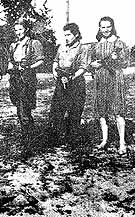
|
|
|

|

|

|

|
|
Click on an image to see a larger, more detailed picture.
|
|
|
|
|
| 1943: Death and Resistance |

|
pg. 464 |

|
|
|
|
| |
 With gun held at the ready, Vitka Kempner (right) stands with fellow partisans Zelda Treger and Raizel Kartshak. Even among the partisans, Kempner was regarded as exceptionally daring. In early July 1943 she sneaked out of the Vilna (Lithuania) Ghetto with a homemade bomb, which she used to blow up a German munitions train. Although wounded, she walked three days and nights to return to the ghetto. She later carried on her heroic activities from the forests, helping Jewish slave laborers to escape from Keilis, near Vilna, and joining with other partisans to destroy a factory.
With gun held at the ready, Vitka Kempner (right) stands with fellow partisans Zelda Treger and Raizel Kartshak. Even among the partisans, Kempner was regarded as exceptionally daring. In early July 1943 she sneaked out of the Vilna (Lithuania) Ghetto with a homemade bomb, which she used to blow up a German munitions train. Although wounded, she walked three days and nights to return to the ghetto. She later carried on her heroic activities from the forests, helping Jewish slave laborers to escape from Keilis, near Vilna, and joining with other partisans to destroy a factory.
Photo: Yad Vashem
|
 The pro-Axis grand mufti of Jerusalem, Hajj Amin al-Husseini, inspects the rifle of a Bosnian-Moslem Waffen-SS volunteer. As a leader of Arabs and Moslems, al-Husseini saw the Axis powers as the means to gain Arab independence and to destroy the Jews. Although he failed to achieve his dream of an independent Arab legion, he was more successful in persuading some 20,000 Bosnian Moslems to join volunteer units called the Handjar (Sword). Incorporated into the Waffen-SS, these troops proved effective in hunting Jews and partisans.
The pro-Axis grand mufti of Jerusalem, Hajj Amin al-Husseini, inspects the rifle of a Bosnian-Moslem Waffen-SS volunteer. As a leader of Arabs and Moslems, al-Husseini saw the Axis powers as the means to gain Arab independence and to destroy the Jews. Although he failed to achieve his dream of an independent Arab legion, he was more successful in persuading some 20,000 Bosnian Moslems to join volunteer units called the Handjar (Sword). Incorporated into the Waffen-SS, these troops proved effective in hunting Jews and partisans.
Photo: Bundesarchiv / United States Holocaust Memorial Museum Photo Archive
|
 The Nazis hang 20 prisoners in the Buchenwald, Germany, camp, a reprisal for the killing of a German guard. As usual, the entire camp was forced to view the executions. The Nazis hoped that the inmates would conclude that such resistance would never go unpunished, and that the innocent would suffer along with the perpetrators.
The Nazis hang 20 prisoners in the Buchenwald, Germany, camp, a reprisal for the killing of a German guard. As usual, the entire camp was forced to view the executions. The Nazis hoped that the inmates would conclude that such resistance would never go unpunished, and that the innocent would suffer along with the perpetrators.
Photo: Main Commission for the Investigation of Nazi War Crimes / United States Holocaust Memorial Museum Photo Archive
|
|

|

|

|

|
 July 14-17, 1943: The "Krasnodar Trial" of 13 alleged Soviet collaborators opens in the Caucasus region of Russia. Eight are sentenced to death; three are sentenced to 20 years' imprisonment; two are acquitted.
July 14-17, 1943: The "Krasnodar Trial" of 13 alleged Soviet collaborators opens in the Caucasus region of Russia. Eight are sentenced to death; three are sentenced to 20 years' imprisonment; two are acquitted.
|
 Mid-July 1943: Germans execute Professor Kurt Huber, an anti-Nazi activist and part of the Munich-based White Rose student resistance group.
Mid-July 1943: Germans execute Professor Kurt Huber, an anti-Nazi activist and part of the Munich-based White Rose student resistance group.
|
 July 16, 1943: At Vilna, Lithuania, police invade a meeting between members of the United Partisan Organization and Jacob Gens, head of the Vilna Jewish Council, and seize its leader, Yitzhak Wittenberg. Outside, Jewish partisans attack the police and free Wittenberg; See July 17, 1943.
July 16, 1943: At Vilna, Lithuania, police invade a meeting between members of the United Partisan Organization and Jacob Gens, head of the Vilna Jewish Council, and seize its leader, Yitzhak Wittenberg. Outside, Jewish partisans attack the police and free Wittenberg; See July 17, 1943.
|
|
|
|
|
| 1943: Death and Resistance |

|
pg. 464 |

|
|
The Holocaust Chronicle
© 2009 Publications International, Ltd.
|
|
